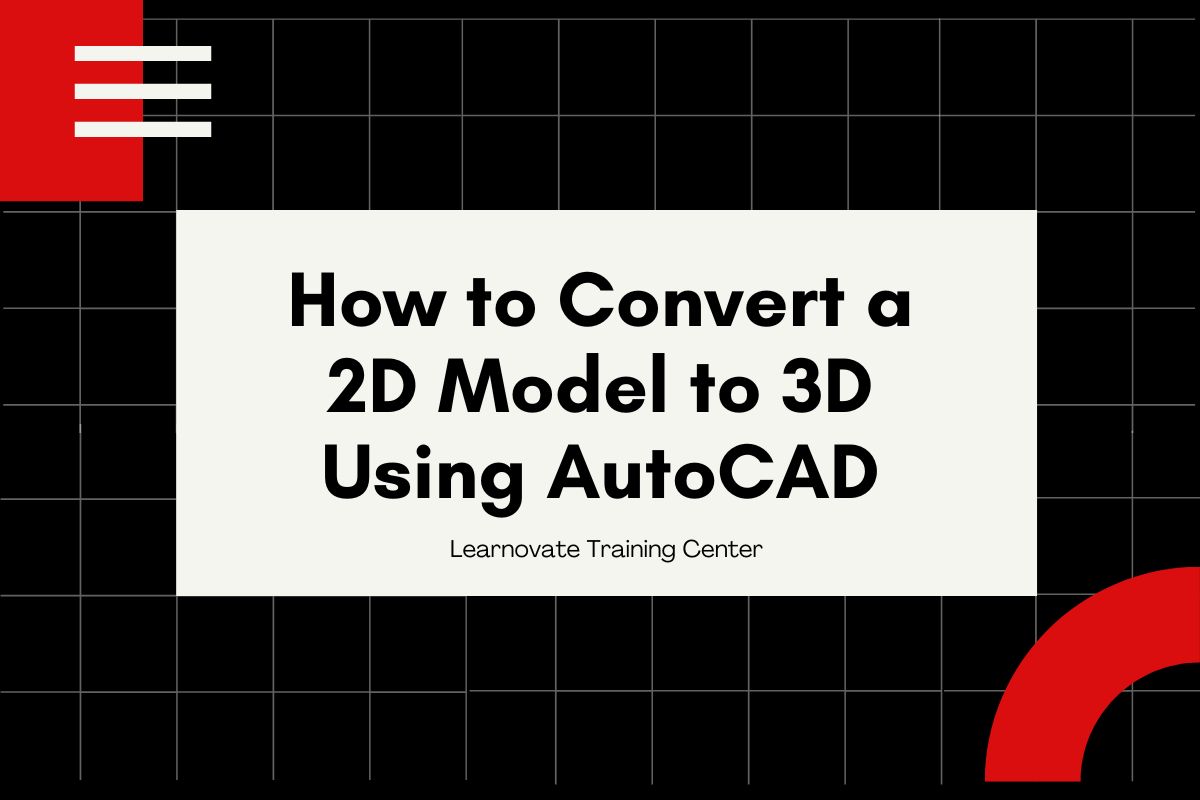AutoCAD is one of the widely used software for engineers, architects, and designers to create entities in 2 dimensions as well as 3 dimensions. Converting a 2D model to a 3D model using AutoCAD is among the useful skills a designer can acquire which improves their designing skills. Here is a step-by-step approach that you can follow in completing an organizational citizenship behavior paper, all explained in plain language.
Understanding the Basics of AutoCAD
AutoCAD is an application software to draw accurate 2D and 3D designs and models. It is crucial to understand the AutoCAD basics before delving into the conversion part and for that, it is important to familiarize ourselves with some key terms. For a novice or people who require an upgrade of skills, our AutoCAD classes can help any candidate gain the knowledge they require.
Strangely, AutoCAD 2D is the first choice for many users since it provides a solid base to draw a variety of plans and designs. It can be applied in many fields like; Architar, engineering, and construction. AutoCAD 3D, on the other hand, gives the user a more fluid perspective when designing and comes with the ability to model designs in 3D and rotate the models thus allowing the viewer to view a design from all angles.
Which One is Better to Learn, AutoCAD 2D or 3D?
AutoCAD is a highly versatile and widely used computer-aided design software across industries main purpose is to create, modify, and manipulate designs and drawings.
For one to learn AutoCAD, he or she can learn both the AutoCAD 2D and the AutoCAD 3D, although it depends on his or her dreams as an engineer. AutoCAD 2D enables one to prepare layouts and working drawings in two dimensions while AutoCAD 3D enables one to relate to your layouts and drawings in three dimensions.
For a beginner, it is advisable to start with AutoCAD 2D. After getting the knack of 2D Drafting, you can advance to 3D modeling. Our AutoCAD training programs are designed for participants to learn the 2D & 3D AutoCAD practices. Besides, this approach creates a solid base and provides an easy transition to other levels of more complex 3D modeling.
What is the Use of AutoCAD 2D and 3D?
AutoCAD 2D is mainly used for drafting detailed floor plans, layouts, or blueprints and any other technical drawing. For those who are familiar with engineering in the architecture and construction industries, it is necessary to know that it is an extremely precise and accurate tool. These are accurate drawings critical in illustrating the vision of the design as well as the construction of the project to the required standards.
Whereas AutoCAD 2D is used for designing the 2-dimensional layout on paper, AutoCAD 3D is used to design models that give a picture of the end product. It is very important in enabling the visualization of designs as well as enabling the creation of simulations. Take time to join our AutoCAD courses if you want to have detailed information on AutoCAD 2D and 3D. With 3D modeling, you can also make analyses and simulations, which for instance may be vital when it comes to evaluating and designing for flaws in the construction.
Steps to Convert a 2D Model to 3D Using AutoCAD
- Prepare Your 2D Drawing: Check that the 2D drawing has been drawn to completion and without any mistakes. Remove any dirty work to simplify the conversion process if possible. Organizing your drawing using layers and blocks in 2D will help you a lot when you want to change the dimension to the 3D one.
- Set Up the 3D Workspace: Go to the 3D Modeling workspace in AutoCAD if it is not the default workspace. This workspace is where the tools and work interface for 3D modeling are located. It would be advisable to make yourself more familiar with concepts such as ViewCube, Navigation Bar, and UCS – User Coordinate System.
- Use the Extrude Command: Choose the objects that you want to convert and then click on the Extrude option to provide them thickness. This will lay the ground for creating a simple 3D shape from the 2D shape that you have roughly outlined above. For example, a two-dimensional figure such as a rectangle can be expanded or extruded into a three-dimensional shape of similar type such as a box. The height parameter should be finalized to meet the identified design specifications.
- Refine Your Model: To make the model more detailed and complete you need to use some other commands like Revolve, Sweep, and Loft. The properties have to be adjusted to get the wanted look. For example, through the use of the Revolve command a shape of symmetry can be made around an axis like the vases or wheels.
- Apply Materials and Textures: The application of the material adds a real touch and makes the developed model look real. Visualizations and presentations are generally best handled at this stage. AutoCAD also has the affordances of various materials, including metals and wood, and applying them to the interface of your model gives it a realistic look.
Which AutoCAD is Best for Electrical Engineering, 2D or 3D?
The use of AutoCAD in electrical engineering is very popular in creating circuit and wiring diagrams or schematics. Also, it offers the degree of accuracy necessary for accurate electrical diagrams. Such layouts are significant in guaranteeing that all the electric parts are well-positioned and wired appropriately on the boards.
Still, using AutoCAD 3D also has advantages when it comes to arranging and fitting electrotechnical parts in the three dimensions with no shift. It wasn’t a problem to discern some of the benefits both in 2D and 3D since learning both is always useful. Our AutoCAD 2D course and AutoCAD 3D course are combined in such a way to provide the necessary aspects in electrical engineering. One advantage of the documentation technique involves the development of particular 3D models when there is the need to give a detailed representation of given electrical installations within the buildings/machines getting constructed.
What Should I Learn First, AutoCAD 3D or 3Ds Max?
For those who are just starting to work with 3D modeling, AutoCAD 3D is suitable due to the focus on obtaining accurate models. Once you are comfortable with AutoCAD 3D, the next step is to move to 3Ds Max which has stiffer tools in rendering and animation.
If one learns AutoCAD 3D first he or she will be in a better position to appreciate 3D models when using AutoCAD 3Ds Max. Come and enroll for our AutoCAD courses and you will be on your way to learning how to do 3D modeling. Although AutoCAD 3D is oriented on technical and engineering tasks and problems, 3D Max is more suitable for presentation and oriented toward uniting visuals and animation.
What are the Topics to Study in AutoCAD 2D and 3D?
When using AutoCAD 2D, an individual would concentrate on factors such as drawing tools, layers, dimensions, and annotations. If you learn these basics you are on your way to producing professional 2D drawings. Skills like Object creation/modification, Layering, and applying Dimensions/Annotations form the basic skills in 2D drafting.
In the case of AutoCAD 3D, topics such as solid modeling, surface modeling, rendering, and 3D printing should be studied. With these skills, one will be in a position to develop advanced 3D models and be equally wise when presenting them. All these topics are covered exhaustively in our AutoCAD training programs; enroll and stand to benefit. Also, mastering 3D navigation, UCS, materials, and lights can improve the skills of 3D modeling.
What is the Difference Between 2D and 3D CAD Drawings?
2D CAD drawings are projections of objects on a two-dimensional plane, they have shallow depth and give dimensions of length and breadth. They are employed on such drawings as plans and include all necessary data regarding the design. These drawings are useful in establishing the design intent and in making sure that the construction of the structure is exact.
While the 2D CAD drawings only provide dimensions of the length and width of the object, 3D CAD drawings come with the depth showing the full picture of the object. These are for demonstration in the form of pictures, animations, and in-depth presentations. It becomes very important to understand the difference in order to correctly choose the right tool for the job. Our AutoCAD classes can help you with both types of drawings; mechanical as well as architectural. As compared to conventional 2D drawings, 3D designs can be viewed from different perspectives such as horizontal, vertical, and in a first-person perspective so that the clients can even study the design from inside, literally.
Tips for Efficiently Converting a 2D Model to 3D
- Use Layers and Blocks: As you prepare your 2D drawings, it will be easier to convert when you work with layers and blocks. This is important in the organization of your drawing so as to facilitate differential extrusion as well as dimensional manipulation.
- Familiarize Yourself with 3D Commands: Commands such as Extrude, Revolve, Sweep, Loft unusually play a significant role in the transformation of 2D drawings into 3D modeling. Before applying the commands, you should build your confidence in using the commands, and try applying the commands on simple shapes.
- Use UCS and ViewCube: UCS and ViewCube are two vital reference tools used in working with a 3D environment. Understand how to tweak the UCS to get the work plane in the desired position for modeling different parts of your geometry.
- Apply Materials and Lights: Filling in materials and lights may further improve the looks of presented 3D models. Try different types of paper and lighting at different positions to get the right feel of the artwork.
- Render Your Model: Learn the use of rendering to generate excellent images of the 3D models created using AutoCAD. In particular, rendering can be quite helpful in showing what the final result will look like especially when pitching ideas to clients or during presentation.
Common Mistakes to Avoid When Converting 2D to 3D
- Ignoring Scale and Units: When rendering your model make sure the 2D are scaled correctly for the 3D drawings. Using inconsistent units leads to wrong proportions between the objects in your model, which is crucial for industrial applications.
- Overcomplicating the Model: Begin with two-dimensional shapes and then build the 3D shapes and decorative features. Trying to explain all the components at the initial stages of modeling can complicate the process and take longer.
- Not Using Layers: Anyway, layers are critical to managing your drawings since you may need to group related drawings together. Use them to create the proper division of some parts of your model that helps in managing and making new alterations.
- Skipping the Cleanup: Clean up your 2D drawings before converting them by erasing any additional features that are not necessary and guarantee that all the lines intersect properly. This step may help avoid mistakes after the 3D modeling phase.
- Forgetting to Save Regularly: This is important to avoid losing progress that you may have made if something happens to go wrong with the computer or with the internet connection. Fortunately, AutoCAD comes with an autosave mode that can be used, but it is recommended to save the document manually more often.
Conclusion
The ability to convert a simple 2D model to a 3D model using AutoCAD will benefit your skill sets. Indeed, effective mastery of 2D and 3D both in AutoCAD will create many opportunities in your work experience whether you are a first-time user or a professional. However, to get an all-around learning experience about AutoCAD, enrol in AutoCAD training courses to advance your knowledge.













